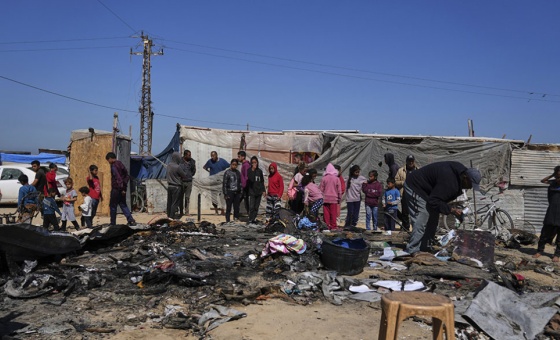This is the last article you can read this month
You can read more article this month
You can read more articles this month
Sorry your limit is up for this month
Reset on:
Please help support the Morning Star by subscribing here
THE central committee of Argentina’s oldest and largest trade union confederation, the CGT, has announced that there will be a general strike on April 10, to protest against the anti-worker policies of President Javier Milei’s right-wing administration.
The organisation’s leadership has been put under considerable pressure by its constituent unions to take action as thousands of jobs in both the public and private sectors have been lost.
Since the last general strike almost a year ago, the real value of wages has fallen dramatically in the face of persistent inflation, and legislation has been introduced to curtail employment rights, during which time there has been a growing perception that the CGT was missing in action.
An announcement by the Ministry of Labour that all wage negotiations in Argentina’s centralised sectoral bargaining framework would henceforth be limited to a maximum of 1 per cent per month (February’s inflation figure was 2.4 per cent) undoubtedly tipped the scales in favour of industrial action.
Although nearly 40 per cent of the Argentine workforce is in the informal economy, ie not registered with social security, meaning that they have no rights to pensions, benefits or protection against dismissal, the CGT still has sufficient numbers in key areas to bring the country to a standstill.
On March 20, when the strike was called, the CGT also stated that it would formally support the demonstrations every Wednesday outside the national congress by retired people protesting against swingeing cuts in the value of their pensions.
These demonstrations gained international prominence on March 12 when protesters supported by a coalition of football supporters were savagely assaulted by the massed ranks of paramilitary police who used batons, tear gas and water cannon against the crowd.
Among hundreds of people injured were an 87-year-old woman, clubbed to the ground, and a photojournalist, critically ill in hospital after being deliberately targeted by a policeman firing a tear gas grenade.
Unsurprisingly, some elements of the European press swallowed the government line that the police had merely reacted to being attacked. If President Milei and his psychopathic security minister, Patricia Bullrich believed that the brutal show of force would dissuade the protesters, they were very wrong.
On the following Wednesday, thousands more pensioners and their supporters massed outside the congress building. Again, there was a huge police presence, though it appeared that the authorities had learned their lesson and wanted to avoid the wave of negative publicity that followed the police riot on the 12th.
Instead of attacking the crowd, a triple wall of metal barriers was erected to keep demonstrators well away from the parliament and surrounding streets were cordoned off. In a further Orwellian measure, loudspeaker messages were directed at passengers arriving at Buenos Aires’ main railway terminus, warning them to keep away.
There were more huge crowds marching on March 24, the day when Argentines commemorate the beginning of the military dictatorship in 1976. For the second year running the CGT gave the event its official support, when previously they had never done so.
Over 400,000 thronged the streets of the capital and in Argentina’s second and third cities of Cordoba and Rosario, an unprecedented number of people turned out under the slogan of “nunca mas” (“never again”).
As they did in 2024, the government responded to Memorial Day by broadcasting a video that was aired on social media and television, stating that the official figure of 30,000 people disappeared during the seven years of the dictatorship was a myth and that the military was fighting terrorist insurgents.
In reality, the majority of those killed or disappeared were trade unionists, students, militants and leftist intellectuals who were not involved in armed struggle. The coup was prepared and designed by large corporations and a group of economists from Argentina and the US, led by Jose Alfredo Martinez de Hoz who would become the military junta’s economy minister.
Aided by a generous loan from the IMF immediately after the coup, Martinez de Hoz imposed a series of neoliberal policies that benefited the business class in much the same way that Milei is doing today, the difference being that Milei does not have a military dictatorship to support him.
On March 19, amidst tumultuous scenes, the chamber of deputies approved an executive order that would allow Milei and the government to seal a new agreement with the IMF about which no details were provided, despite a 2001 law stipulating that all loans had to go through congress. Milei’s use of an emergency decree enabled it to conceal the content of the negotiations, meaning that the deputies voted on something they knew little about.
More recently, the current economy minister Luis Caputo said that the loan was $20 billion to be disbursed straight away, a claim that was almost immediately contradicted by the IMF stating that it would be issued in tranches as per their normal procedure. Caputo was undoubtedly trying to bolster market faith in the Argentine economy and reduce the inflationary pressures that threaten to overwhelm the government’s economic programme.
Unfortunately for him, it is the IMF who will ultimately decide if there is to be a complete liberalisation of the dollar exchange rate that would inevitably have an inflationary effect and occasion balance of payments difficulties.
The interest on debt repayment in 2024 was nearly $13 billion and even though it has never been easier for foreign capital to enter Argentina, the inward investment from abroad in 2024 was the worst of the century.
Milei’s popularity abroad among the ranks of the ultra-right has probably never been stronger and he is feted by the European and US financial press for his economic “reforms.” At home, his popularity has waned, though not as much as might be expected given their effect.
Poverty levels are at record highs and organised crime is filling the gaps in deprived urban areas where the removal of basic social security and education grants has left young people without income or hope. The question is where the opposition to Milei will come from.
He has done an excellent job in rubbishing what he refers to as the political “caste” and there is little resistance from politicians who have been comprehensively delegitimised or, alternatively, effectively bought off.
The mainstream unions are compromised by the corporatist structure within which they operate and are prone to adopt bland positions in the “national interest” rather than engage in any form of class struggle. It would appear then that change will have to come from the streets.
The years of the pandemic and the effects of the digital age have weakened Argentina’s social cohesion, but the tradition of street protest is still alive. When Milei maligned the LGBTQ community at Davos, it precipitated a huge protest march in Buenos Aires and, last year, there were similarly large turnouts by students in support of their beleaguered institutions.
Whether these disparate groups can ever come together to mount a serious challenge to Milei’s awful regime remains to be seen.







